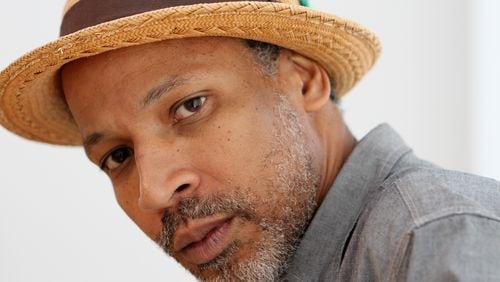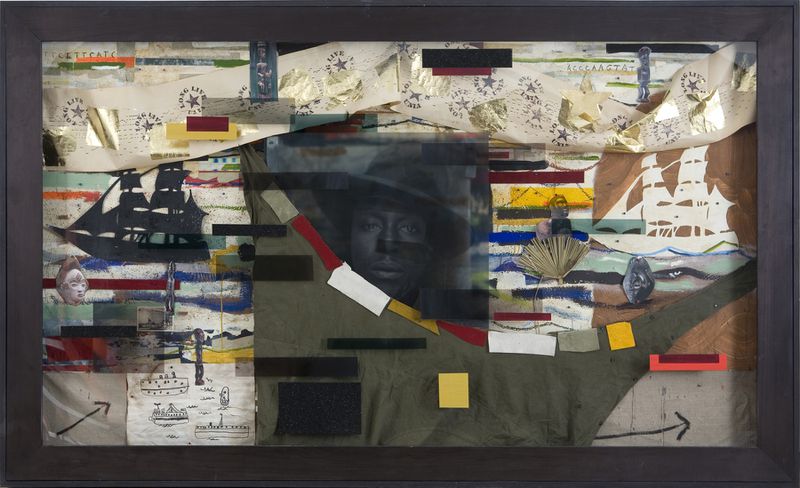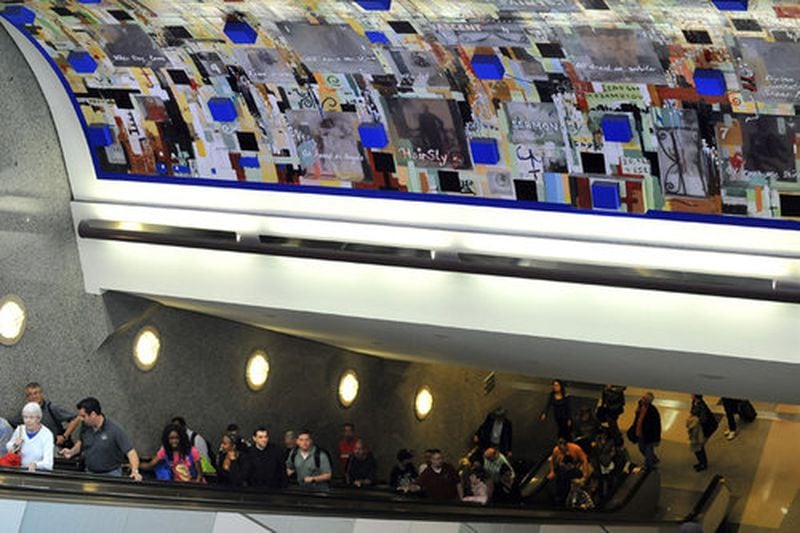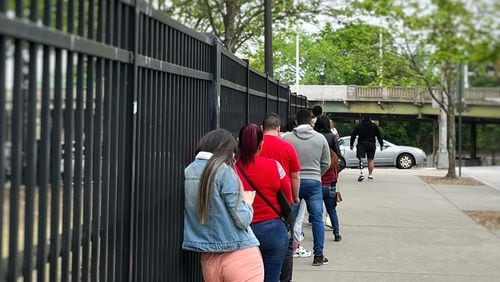In an Atlanta art scene that often struggles for national and international recognition, painter and sculptor Radcliffe Bailey was in the catbird seat.
His transportive and conceptually rich mixed media works commanded attention outside Atlanta and the United States. Bailey’s works landed in collections at the country’s most prestigious institutions including the Art Institute of Chicago, the Metropolitan Museum of Art in New York City, the Museum of Fine Arts in Houston, the Studio Museum in Harlem and the Smithsonian Institution.
His moving, visually layered works incorporated paint, glitter, glass and found objects including burlap, rusted steel, vintage black-and-white tintypes from family photo albums, red Georgia clay and piano keys. His multimedia artworks were deeply invested in America’s Black experience with its many tribulations and triumphs.
Bailey created complex visual tapestries combining memory, migration and both African and African American history. He treated the Middle Passage and slavery’s legacy with gravity and depth. His work recognized Black pain but also conveyed transcendence and a spiritual journey that rose above trauma. Long before Black audiences demanded that not just Black trauma, but Black joy be represented in culture, Bailey’s work was doing that.
Credit: HANDOUT
Credit: HANDOUT
Almost inseparable from the city where he lived, in many ways Bailey’s work and life represented the best of a city founded on Black excellence and achievement.
He lived in a sleek modern home in his Cascade Heights neighborhood. That 7.5 acre piece of land in southwest Atlanta included several remnants from the Civil War. He was deeply rooted in that neighborhood.
“His work is about people who grew up in that community, the stories still carried on the wind and on the streams that run into the woods behind his house,” said friend and artist Fahamu Pecou who met Bailey in 1994 when Pecou was a student at the now defunct Atlanta College of Art.
“Atlanta is as much a part of Radcliffe’s work as he is a part of Atlanta,” said Pecou.
The city lost a part of its soul and identity on Nov 15, when Bailey died from brain cancer.
Born in 1968 in Bridgeton, New Jersey, Bailey moved with his family to Atlanta in 1972 when he was four years old. He played baseball and began to gravitate toward the art world, encouraged by his schoolteacher mother — in one memorable encounter he met Jacob Lawrence at the High Museum. He graduated from Benjamin E. Mays High School and received his bachelor’s in fine arts from the Atlanta College of Art in 1991.
Spelman College Museum of Fine Art curator-in-residence Karen Comer Lowe met then art-student Bailey on a double date when she was 19 years old and a student at Howard University. She remembers him wearing a pair of jeans that he had drawn on.
“And so I said, ‘I want a pair.’ And he said ‘I’ll get you a pair.’” Lowe said that that joking repartee about the promised art-ornamented jeans went on for years as Bailey’s reputation grew. Bailey finally told her he couldn’t make her the jeans. “Now, this is business,” he told her.
“So I never got the jeans,” Comer laughed.
She watched his progress as he landed solo shows at McIntosh Gallery, at Solomon Projects and in 1993 at the city’s premiere blue chip art gallery, Fay Gold. In 1999 Bailey took another leap forward with a solo show at Jack Shainman Gallery in New York City.
In 2011 Bailey received a solo exhibition at the High Museum of Art, a rare occurrence for an Atlanta-based artist, The show traveled to the Wellesley College Museum in Massachusetts and the McNay Art Museum in San Antonio, Texas. His massive touchstone installation for that show “Windward Coast” featured an undulating sea of thousands of piano keys and a single Black man’s head swept up in that current. The New York art magazine Artforum called it “an overwhelming visual experience.”
He was ahead of the curve on many fronts said his New York gallerist Jack Shainman.
“His work seemed mature, even from a young age…he was examining themes of blackness during a time when that wasn’t really done,” Shainman said.
“Radcliffe’s work was so personal to him and yet so relatable and relevant to so many others,” he said. “It is rare to work with an artist willing to reveal so much of themselves within their work, almost as though it built a trust between him and his viewers.”
Music, his friends note, was a feature of both Bailey’s work and life. Piano keys, sheet music, brass instruments and vinyl records were often components of his mixed media artworks.
“He was just a music guy,” Pecou said. “He was very much in conversation with, you know, the magic and spirituality of Black music.”
Deeply enmeshed in the city’s house music scene, Bailey could often be found dancing at local spots such as the Sound Table, the Yin Yang Cafe and MJQ. In 1992 he appeared wearing overalls and painting an image of a lynched man in the video “Tennessee,” a song by Arrested Development. Its lyrics were about the South’s tainted racial history and Black spirituality, which aligned with Bailey’s own investigations of how the past abrades and shapes the present in his artwork.
His sweetly mischievous smile, trademark fedoras and hands clasped in a gesture of prayer as greeting gave him the aspect of a wise, benevolent art monk. But friends like artist and curator Ed Spriggs, who met Bailey in 1998 when Spriggs was at the Fulton County Arts Council, said that there was depth and maturity beneath that playful demeanor. He was, Spriggs said, “a young artist but mentally out of another generation.”
In 2017 Bailey created the 84-foot “Conduits of Contact” for Mercedes-Benz Stadium which featured athletes from Atlanta’s HBCUs. “There are so many monumental pieces here in Atlanta,” said Spriggs of the way Bailey’s legacy is woven into the city’s landscape. “That’s like a shrine to him as well,” he said.
Lowe remembers Bailey’s particular pride in his commission piece for the E Terminal at Hartsfield-Jackson Atlanta International Airport. His mural “Saints” was installed as part of the 1996 Summer Olympics.
Credit: Hyosub Shin, hshin@ajc.com
Credit: Hyosub Shin, hshin@ajc.com
His private life was often as glamorous as his public one. In 2009 Bailey married former “Young & the Restless” star Victoria Rowell who was walked down the aisle at the couple’s wedding in New Hampshire by actor Samuel L. Jackson.
His current wife Leslie Parks-Bailey is a chef and the daughter of the legendary photographer Gordon Parks.
Bailey is survived by his wife Leslie Parks-Bailey, his daughter Olivia, his son Coles, his brother Roy and his parents Radcliffe Sr. and Brenda.
A celebration of life has been scheduled for 3 p.m. Saturday Nov. 25 at Cascade Springs Nature Preserve, 2852 Cascade Road, Atlanta. In lieu of flowers, the family requests donations in the name of Radcliffe Bailey Jr. to the Hammonds House Museum in Atlanta.








